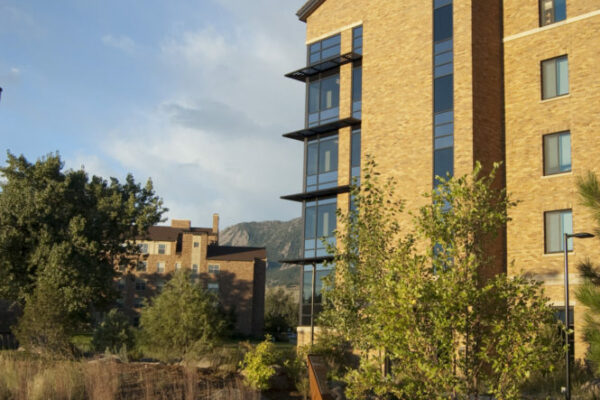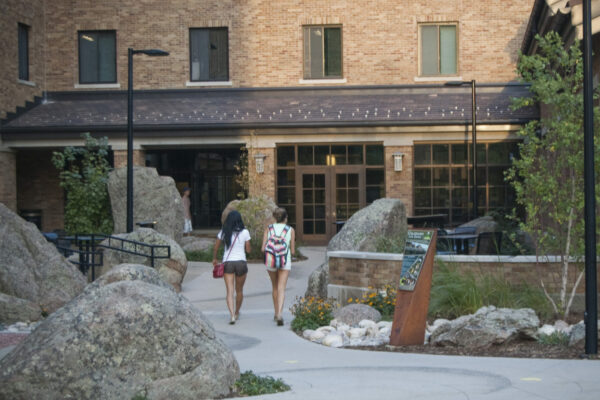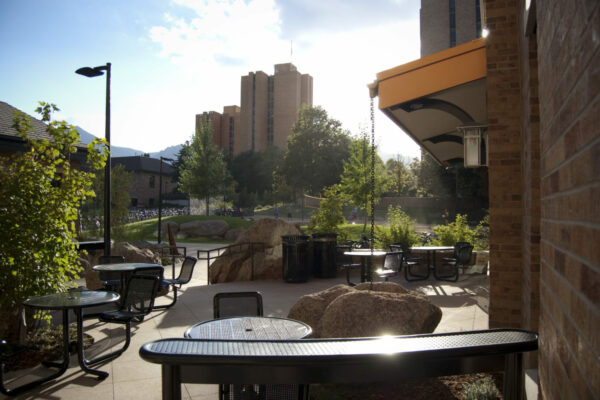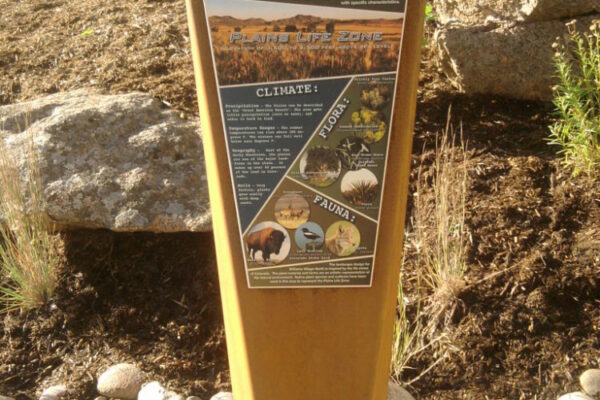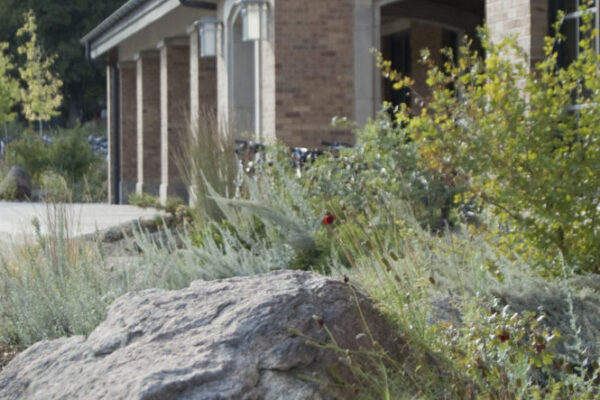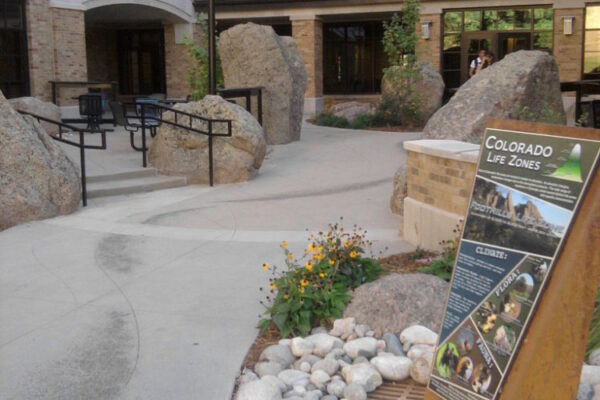Design Overview
The Whiting-Turner Team, with the architectural design leadership provided by Mackey Mitchell Architects and Aller-Lingle-Massey Architects, has examined a variety of architectural solutions and building organization ideas for the design of the new Williams Village Pod C Site. The design solution presents an opportunity to examine the guiding principles established by Charles Klauder, and to take these guiding values and develop a distinctive architectural style for the Williams Village campus.
Through the efforts of the entire Whiting-Turner Team, in collaboration with the Campus Design Workshop participants and members of the Design Review Board, we have proposed an architectural design for the new 500-bed residence hall that will give shape to the Williams Village complex and establish a unique vocabulary for this important part of campus.
The design of this new residence hall provides the rare opportunity to educate the students on sustainable design and building practices. The goal is to establish a living-learning environment that promotes strong, sustainable values on campus and presents the new residence hall as a community committed and focused on promoting sustainable practices on campus.
Design is an evolving process; our proposed design will be collaboratively developed beyond the schematic level, consistent with the discussion the team has had during the workshop sessions and presentation to the Design Review Board.
Site/Building Organization
Understanding the site’s immediate and extended context within the Williams Village complex has been a rigorous part of the design process. Understanding circulation patterns (both vehicular and pedestrian), along with the functional needs of the building, has helped shape this design. The team carefully integrated exterior rooms with landscaping in harmony with the current Master Plan concepts for the Williams Village complex. The building’s organizing principle evolved from the concept of a pinwheel. On the residential floors, we promoted individual identity for each community of 35 students (or fewer) by designing a separate “front door” for each and incorporating all the programmatic needs established by Residential Life. The heart of the residential floors (the pinwheel’s center) provides vertical circulation and a large living room or social lounge that can be used for all-floor or individual community gatherings or functions. This central core is light-filled, providing a constant reference to the exterior. The introduction of natural light is reinforced in the design and layout of each community by the strategic location of social lounges and study spaces at the end of corridors. These individual lounge and study spaces can also be the social heart of each community – a place to see and be seen within the individual community.
Building Image and Massing
Over the past six weeks, the design team has toured the campus and carefully examined the work of Klauder and his successors to understand the guiding principles. Those four design principles, as summarized in the publication Body and Soul by William R. Deno, were a constant reminder to
• Strive for a serendipitous mix of open space and building mass.
• Preserve existing architectural design themes and building materials, but bend the rules with care when necessary.
• Pay attention to human scale in every way.
• Satisfy, to the greatest extent possible, the functional needs of the user, the operational needs of the University, and the aesthetic needs of the designer.
Massing of the building is a direct reflection of the residence hall’s program needs. Understanding the importance of community and designing spaces to foster this collegial spirit were constantly in the forefront as design team members gave shape to the building.
Circulation and Design Efficiencies
As previously discussed, the design team incorporated the power of the pinwheel to establish and promote individual communities of 36 students or fewer, and to do this in an efficient manner. With the addition of the second RAP space, there are 87,935 net assignable square feet (as provided by the University in the detailed program). The original programming document established a building efficiency factor of 67%, which would yield 131,246 BGSF. Again, our solution not only increases the net assignable area (by approximately 5,000 SF), but we were able to design the building with approximately 129,000 BGSF. The current design solution increases the net-assignable to building- gross efficiency from 67% to 72%. Enhancing the building’s efficiency captures additional usable and potentially revenue-generating space (including 1,300 SF of retail), significantly growing the building’s social heart by increasing the Great Room’s 750 NASF programmatic requirement to over 1,700 NASF.
Site Overview
Williams Village represents a new sub campus at the University of Colorado at Boulder. The proposed new phase of housing is occurring at a changing time in the campus’s history and in America. This is a time when humans are recognizing the importance of relating to the land and the environment in a more sensitive manner. The sustainability is moving rapidly and is focused on relating more to natural systems. The concept of the William is thus changing in a way which more closely reflects the Colorado Landscape. The leader in this movement has been the LEED movement established by the United States Green Building Council (USGBC). LEED as a site and building development system focuses on reducing environmental impacts through a systematized approach to construction of new buildings. The University of Colorado has fully embraced this system and the influence is becoming apparent in new construction. A significant component of the LEED rating system relates to site development.
The LEED system approaches site development in a manner which is intended to reduce the environmental footprint of site through reduced water use, reduced parking, and higher water quality in stormwater runoff, reduced stormwater impacts, eliminating light pollution, and use of more native plants.
Indisputably Colorado
These requirements have a direct influence on the appearance of the landscape. Williams Village offers a terrific occasion to begin to demonstrate a new and more indigenous vernacular for landscaping at the University. Through incorporating a 100% Colorado palette (and native cultivars) of plants and through mimicking natural systems to the degree possible, the landscape at Williams Village can serve as a demonstration project for low water use, and low impact design. A native approach also provides an opportunity to distinguish Williams Village and to begin to develop a unique, welcoming, and highly inviting location which will encourage students to stay on the campus. The opportunities for placemaking are extensive. Careful integration of the Colorado landscape through earthforms, stonework, plants, and indigenous surfacing materials, as well as through a more graceful flowing pattern, the Williams Village campus can be a statement of integration with the land. Further, the plan is being developed to educate students and as a tool for faculty to demonstrate the various ecosystems of the state. Thus the concept of being indisputably Colorado.
One clear benefit of a native plant palette will be the creation of wildlife habitat. This is likely to mean increased butterflies, birds, and small mammals.
A side benefit of the native landscape will also be a reduction or elimination over time of the use of pesticides and herbicides. Toxic materials commonly used in irrigated turf areas to control weeds and to fertilize bluegrass should not be necessary after establishment, although some of these may be necessary for the first few years until native plants can grow in.
Another benefit will also be reduced mowing and a subsequent reduction in use of fossil fuels and carbon emissions.
Village Green
College Campuses should reflect the contemporary nature of students and the times as well as the grandeur of timelessness. Perhaps no other institution in the Mountain West Region of the United States exemplifies this better than the University of Colorado. The successful site design must address both of these characteristics. Designed with the flavor of Tuscany but with a touch of “Hip” the overall plan for the Williams Village site and landscape bring together a variety of interesting elements designed to create a unified village that is an end destination for living, entertainment, and relaxation. With strategically developed lines of focus on the center of the village, concepts are put into place to encourage students and faculty to “hang” at the Village and interact in a variety of opportunistic settings. The strength of the plan lies in the central Village Green. The Green is designed to encourage people-watching, recreation, dining, improvisational and programmed performances or, for just relaxing under the shade of a Cottonwood. A semi- circular amphitheater anchors the green with a stage and expansive Lyons sandstone blocks. Developed in a staggered curve the sandstone blocks establish a multi-purpose green which creates the opportunity for an amphitheater for performances, or as an informal seating area for just lounging in the afternoon sun. The grass area has a large enough turf area for throwing Frisbees, or informal activities while still preserving the adjacent soccer fields. We do recommend, if possible, eliminating the fencing surrounding the soccer fields.
We suggest the earthwork of the green be modified to create a broad rolling green punctuated with large sweeping berms modulated by the curved amphitheater stones. The combined integration of these two forms unite to form multiple opportunities for students to either be an active part of the setting, or to sit quietly in a passive position of observance.
The Village Green is the hub of bicycle and pedestrian transportation modalities which are the major form of circulation. Additionally the East/West Promenade has been accentuated to further enhance circulation from both the Buff Bus transit stop and RTD. The axial symmetry from Baseline and from the Buff Bus intersect at the Village Green and provide an excellent form of unsigned wayfinding.
Integration
The site plan harmonizes with the architecture in an interlocking manner to achieve complete integration. Recognizing the numerous directions from which students depart and arrive, the proposed plan opens to all sides allowing for a multiple points of access and egress. The landscape setting is permeable and yet secure at the same time. Integrating fully the building and the landscape, the gardens traverse the various neighborhood wings and offer opportunities for quiet study, small gatherings, or outdoor classrooms. The West RAP is connected directly to an outdoor classroom courtyard.
